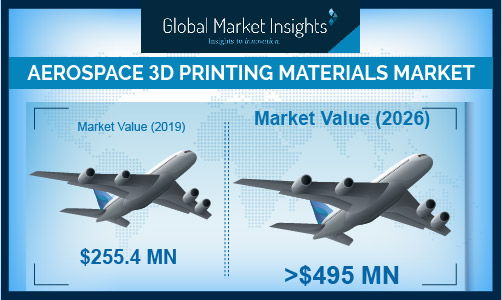Rise in space exploration activities along with expansive proliferation of aircrafts across military & defense sector will drive global aerospace 3D printing materials market outlook. NASA has installed plastic 3D printer in the ISS (International Space Station) that prints parts using ABS and ULTEM plastic.
Ceramic aerospace 3D printing materials are also witnessing major incorporation in aircraft parts. The material is widely used in aircraft’s landing system for reducing the overall weight and to maintain the core structure for handling high impact force.
Growing popularity of additive manufacturing in the production of intricate lightweight cabin interiors of aircrafts will favor business growth over the coming years. Reports suggest that global aerospace 3D printing materials market size will cross the USD 495 million mark by 2026.
Demand for rapid prototyping
Rapid prototyping is experiencing high demand to enable low production volumes through fabrication of intricate trial prototypes through aerospace 3D printing materials. In addition, it allows a cost-effective trial to validate an aircraft part before rolling out a full-scale manufacturing. The method of rapid prototyping is highly accurate and is ideal for aerodynamic analysis and the testing as the surface finish that is achieved through the method is often an excellent representative of a final part.
3D printing is now routinely explored to create and manufacture aerospace components that rely on aesthetics more than function, such as light housings, door wheels, control wheels, interior dashboard designs and others. Rapid prototyping applications will generate a revenue of over USD 105 million a year by the end of 2026.
Growing customization applications
3D printing technologies’ significant impact on aircraft design is resulting in the improvement of aircraft performance. An average corporate aircraft travel 75,000 miles every month and a single component that is designed and manufactured with the help of 3D printing can reduce air drag by 2.1%, and fuel costs by approximately 5.41%. Such small adjustments through customization can save huge expenditure.
Several parts can be tailored or customized to a specific aircraft like bracketry, or type of aircraft including passenger, helicopter or cargo. Apart from this, 3D printing also provides topology optimization and part consolidation of many custom aerospace components.
3D printing of jigs & fixtures
Jigs & fixture aerospace 3D printing materials market size is estimated to showcase a steady growth over the coming years on account of the extensive usage of the components for enhancing the accuracy and quality of the manufacturing process of aircrafts. Utilization of the materials aids in reducing the production cycle times, enables reduced investments along with faster production cycles.
Military & defense applications
The military & defense sector is heavily investing in additive manufacturing to produce utility hydraulic panels and landing gear door. Rising geopolitical tension resulting in high military expenditure will boost the consumption of aerospace 3D printing materials in military aircrafts in the coming years. From military and defense application, the aircraft segment will garner gains at 18% through 2026.
Airline fleet expansion in Asia Pacific
APAC holds a major share in aerospace 3D printing materials industry, witnessing heavy growth over the next few years. Countries in the region including India and China are likely to double their airline fleet in next two decades owing to increased regional passenger traffic. In addition, improvement in fuel efficiency of the aircrafts through weight reduction will further drive regional aerospace 3D printing materials market.
About the author:
A content developer by choice, Saipriya Iyer holds a rich experience portfolio of more than five years in the content creation domain. Equipped with substantial expertise across the business, technology, and finance domains, Saipriya currently pens down insightful articles that combine her knowledge of software technology and electronics.






